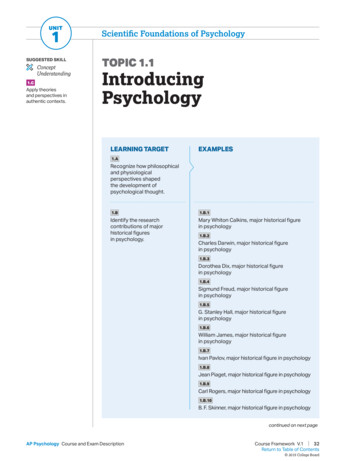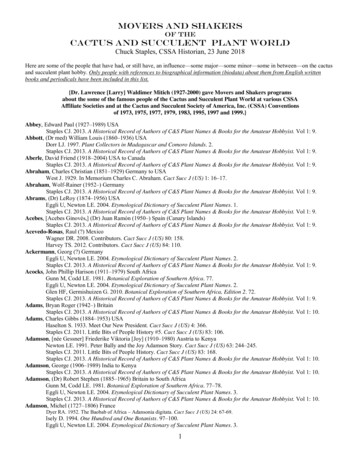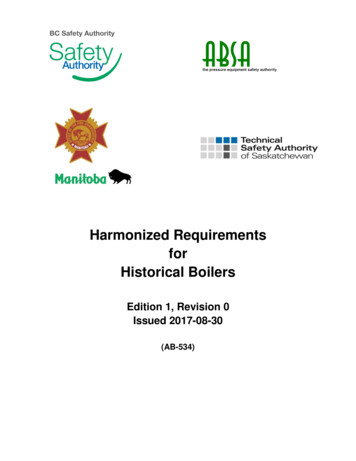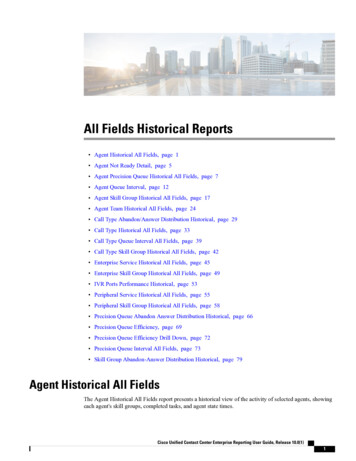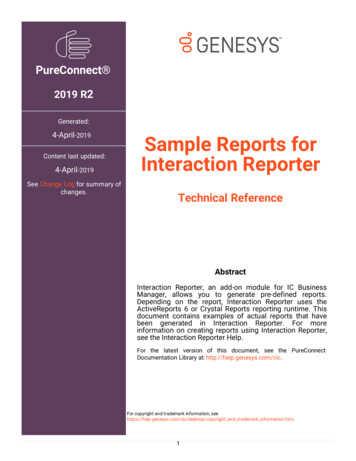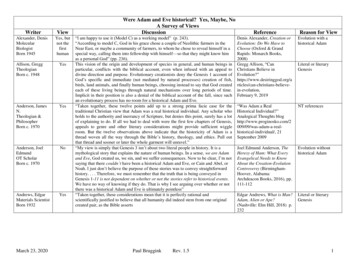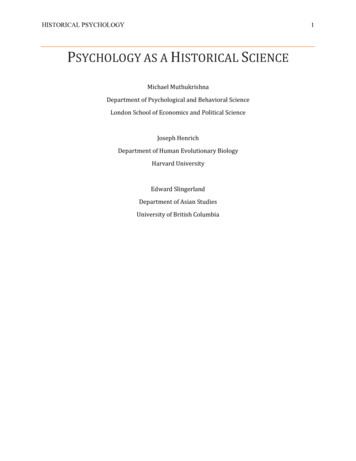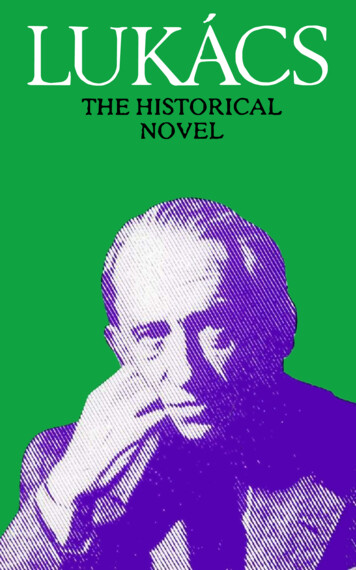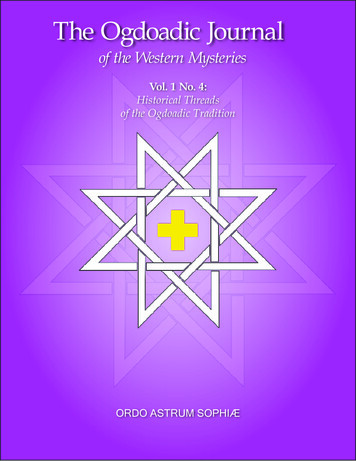
Transcription
The Ogdoadic Journalof the Western MysteriesVol. 1 No. 4:Historical Threadsof the Ogdoadic TraditionORDO ASTRUM SOPHIÆ
The Ogdoadic Journalof the Western MysteriesVol. 1 No. 4:Historical Threadsof the Ogdoadic TraditionEdited byDerik Richards & Kerry WisnerTempus Consilii 2010 2010 by Sun Lion PublicationsORDO ASTRUM SOPHIÆAll rights reserved.
This issue of the Ogdoadic Journalis dedicated to the memory ofComes Semper in ArboreSo Light and Life shall be drawn at last to theradiance of one Star, and that Star shall mount to theunshadowed height.Κρατῆρα μέγαν πληρώσας τούτου κατέπεμψε,δοὺς κήρυκα, καὶ ἐκέλευσεν αὐτῷ κηρύξαι ταῖς τῶνἀνθρώπων καρδίαις τάδε·βάπτισον σεαυτὴν ἡ δυναμένη εἰς τοῦτον τὸν κρατῆρα,ἡ πιστεύουσα ὅτι ἀνελεύσῃ πρὸς τὸν καταπέμψαντατὸν κρατῆρα, ἡ γνωρίζουσα ἐπὶ τί γέγονας.ὅσοι μὲν οὖν συνῆκαν τοῦ κηρύγματος καὶ ἐβαπτίσαντο τοῦ νοός,οὗτοι μετέσχον τῆς γνώσεως καὶ τέλειοι ἐγένοντο ἄνθρωποι,τὸν νοῦν δεξάμενοι·ὅσοι δὲ ἥμαρτον τοῦ κηρύγματος, οὗτοι μὲν οἱ λογικοί,τὸν νοῦν μὴ προσειληφότες,ἀγνοοῦντες ἐπὶ τί γεγόνασιν καὶ ὑπὸ τίνωνHe filled a great krater with Nous and sent it down,and he appointed a herald to make this announcementto the hearts of men:‘Plunge into this krater, if you can, having faith that you will riseto him that sent down the bowl, realizing why you came into being.’Those who heard the proclamation, merged with Nous,partook of higher knowledge and became perfect and complete,since they had received Nous.Those who missed the proclamation had the Word,but had not received Nous,ignorant as they were as to why they were born, and from whom.Corpus Hermeticum IV, 4
ContentsAcknowledgments ivIntroduction vThe Emerald Tablet of Hermes Trismegistos: The Work of the Sun by William Stoltz, MA1Splendor Solis: its Possible Influence on the Ogdoadic System, Part 1 by Kerry Wisner5Understanding Key Numbers: The Thread Connecting the Ogdoadic Tradition by Suzanne Savage15The Florentine Academy of Ficino Part 1: Influence on the Rosicrucian Tradition by Thomas D. Worrel19The Waif a poem by Ernest Page,with notes by Derik Richards24The Religious Reform of Giordano Bruno by Adam J. Schaab26A Mystic’s Gift of Love: The Vision of Edward Carpenter by Finn McMillan34Gustav Holst: Master of Magical Music & Song by John Graham40Thrice Great Hermes: Primal Grand Master & Flame-Bearing Lord of Topaz by William Stoltz, MA44
AcknowledgmentsOn behalf of all companions of Astrum Sophia, the College of Thrones extends oursincere condolences to Companion Anja of the House of Mithras, wife of the late ComesSemper in Arbore. It is therefore most fitting, in light of the true dedication of our recently partedcompanion, that the College of Thrones, Ordo Astrum Sophiae, does hereby posthumouslyappoint Comes Semper in Arbore to the grade of Adeptus, honoris causa.In the Light of the Glorious Star,The College of ThronesHouse of the Winged SerpentOrdo Astrum Sophiae iv
IntroductionThe Ogdoadic Journal of the Western Mysteries is a noncommercial publication of the Ordo Astrum Sophiae(OAS) committed to the ongoing research, teachings andadvancement of the Ogdoadic Tradition. In pursuit ofthis goal it is a presentation of traditional and innovativehermetic literature. The Journal, and future publications,are vehicles of the OAS by Sun Lion Publications, advancing works intrinsic to the Ogdoadic Tradition’s overall vitality and continuation.The majority of the material herein is taken fromthe Order’s internal journal, The Messenger, but relevantcontributions to future editions are also welcomed fromother authors. 1ORDO ASTRUM SOPHIAEOrdo Astrum Sophiae derives its Charter of Succession and initiatory lineage from the Aurum Solis, Orderof the Sacred Word, whichwas founded in Londonin 1897 by George Stanton (pictured right) andCharles Kingold. Thoughproud as the Order is ofits Aurum Solis heritage,it must be emphasized thatthe Astrum Sophia doesnot in any way represent orclaim to be the Aurum Solis. The Ordo Astrum Sophiae is simply the latest manifestation of that great tradition dedicated to the pursuit ofKnowledge and Regeneration as well as the advancementof theoretical and practical studies within the greater Ogdoadic Tradition of the Western Mysteries. The O.A.S. isthus devoted, as both servants and guardians, to a livingand radiant spiritual tradition that expresses itself throughbeauty, diversity, and resilience.Membership and initiation in the Order, withoutexception, must proceed through the traditional gradestructure. Inquiries to the Order should be submitted tothe Administrator-General of the Astrum Sophia atastrum.sophia@gmail.com, or to the Master of a Commandery.The Ordo Astrum Sophiae is a premier initiatory orderof the Ogdoadic Tradition of the Western Mysteries. Asa custodian of the Ogdoadic Tradition the OAS is dedicated to the perpetuation and advancement of the lineageand mysteries of the tradition as handed down throughthe Aurum Solis by Melita Denning and Osborne Phillips.Founded in 2002, the Astrum Sophia is a fullycontacted, non-commercial initiatory Order dedicated tocontinuing and fostering the Ogdoadic Tradition of theWestern Mysteries. The Order’s mission is to provide astable vehicle for the advancement of its members in anambience of living Alchemy and an unwavering devotion THE OGDOADIC TRADITIONto raise its initiates to true Adepthood within the regenerative mysteries of the Ogdoadic Tradition. The Order The Ogdoadic Tradition is a magical current perpetuatis also dedicated to the ideal of fraternal cooperation, ing the lineage and mysteries of the ancient RegenerativeTradition embodying the principle of “Eight.” Essentiallyit is Hermetic, embracing the archetype of and literature1 Individuals interested in making submissions can contactattributed to Hermes Trismegistus. The Hermetica is theastrum.sophia@gmail.com in care of Sun Lion Publications. Articles will beroot source of inspiration and magic in the Ogdoadic Traaccepted at the discretion of the publication team and may be edited, withpermission, to better fit the style or format of the journal.v
Vol. 1, No. 4dition. It is distinct from its Rosicrucian and Thelemiccounterparts because of its unique symbolism, its initiatory structure, the emphasis on the number eight, and theprincipal of Regeneration.To understand the Ogdoadic Tradition it is important to understand the various elements that contributed to its makeup, for it draws upon many traditions andhistorical influences including Egyptian magic, Greekphilosophy, the Mystery religions, Gnosticism, Neo-Platonism, Alchemy, the Qabalah, and Hermetic literature.The principal, archetypal symbols of the Ogdoadic Tradition appear in cultures throughout the world.One of the Tradition’s main symbols is the House of Sacrifice. You need look no further than the Holy of Holiesat Edfu (perhaps the oldest intact remnant of the Houseof Sacrifice) or the Basilica of St. Peter in Rome to seethe ancient and unmistakable design of this House. Youcan also see the design in certain Mithraic artifacts: theseclearly show three steps leading up to the House, whereindwells a Mithraic youth holding the orb of sovereignty,the Sun. The triangular superstructure above containssymbols of power and initiation evidencing divine presence within the holy dwelling.The Star of Regeneration, also a central symbol ofour Tradition, has held a high place in art as disparate asIslam, the Greek Mediterranean, and Christian iconography. Likewise the Tessera, used in both the Astrum Sophia and the Aurum Solis as a symbol of the Great Work,graces numerous sites of antiquity, including the Orpheuspavement at Gloucestershire, England. vi
The Emerald Tabletof Hermes Trismegistos: The Work of the Sunby William Stoltz, MAThe Emerald Tablet is one of the most profound of alltexts attributed to Hermes Trismegistos. One legendreports that the text was originally carved with a diamondon a large piece of emerald by Hermes himself. Thisartifact was supposedly found by Alexander the Greatcradled on the chest of Hermes in an Egyptian tomb. 1If however, we look at more credible origins, the textsof the earliest recorded renditions include a Latintranslation dating from the 11th century CE or earlierand an Arabic version dating before the 8th century CE.Despite its small size (depending on its subdivisions,this diminutive text totals only 12 brief statements) andits survival outside the more widely accepted corpus ofTrismegistic literature, the Emerald Tablet’s formulas,axioms and allegories are entirely compatible with theAlchemical and Hermetic threads within the OgdoadicTradition. It is also interesting, whether coincidental ornot, that the first ten assertions of the text conceptuallymatch the philosophical concepts of the ten CabbalisticSephiroth with remarkable similarity. The remaining twoassertions from the Tablet appear to be descriptive notesand summaries about the author and the text, but not anatural progression of the text’s philosophy and ideas.Like other writings of this nature, interpretationcan take place on several different levels simultaneouslyand carry a different set of interpretations depending onthe system using it. My own commentary accompanyingthis text will therefore be limited to ideas along Hermeticand Qabalistic lines, with the inclusion of a few compatiblenotes from Eastern systems. My own limitations,particularly regarding alchemical symbolism and analysis,are readily overcome by individual meditation andexploration on each of the Tablet’s assertions. Personal1 I doubt if Indiana Jones would go for this one. I prefer the metaphorsuggesting: “The truth and mysteries of Spirit (the text) are written uponthe face of nature (Emerald Tablet) by the mind of God (the diamond).”1 reflection will also help bring the Tablet to life within thepsyche of the student, as it is meant to.1. In truth certainly and without doubt, whatever isbelow is like that which is above, and whatever is aboveis like that which is below, to accomplish the miraclesof one thing.The phrase “In truth certainly and without doubt”appears to addresses two levels of validity. While theword “certainly” seems an impersonal statement of fact,“without doubt” appears to addresses the doubting mindof the individual: the divine word, the Logos, expressedwithin the human psyche.This first assertion also establishes the famousaxiom “as it is above - so it is below,” which is itself thefoundational principle for the law of correspondencesused frequently in meditation and magic; as illustratedin Aleister Crowley’s 777 and Cornelius Agrippa’s setsof correspondences. A Qabalistic equivalent to “as it isabove - so it is below” is the adage “Kether is in Malkuthas Malkuth is in Kether.” This assertion signifies anessential interrelationship of polarities within the processof Creation. The passage also philosophically resolves theimplicit dualism that arises between the ideas of Spirit andMatter. Orthodox Gnostic, Islamic and Judeo-Christianreligious traditions (often rooted in early Zoroastrianism)have made a pastime perpetuating distinctions of goodversus evil between divinity and humanity, illuminationand sex, light and darkness, and even man and woman.Finally, “to accomplish the miracles of one thing”implies that the individual holds an innate capacity toengender the miraculous diversity of a magical universe.This is consistent with the idea that a trained magician,exercising the archetypal qualities of Hermes, is capableof creating variety out of his or her essential unity. This
Vol. 1, No. 4affirming the Alchemical formula of Regeneration. 2The formula of regeneration is further reinforcedin the last part of this passage: “so also are they born fromthis One thing by adaptation.” Clearly, this phrase is notspeaking of common birth but a transformation of theself requiring time, conscious selection and combination.The author(s) of the Emerald Tablet appear to have beenkeen observers of the creative process of adaptation anddiversity within nature. Thus adaptation and learningappear to evolve from the deepest level of our creativeselves and inherent alchemical processes.3. Its father is the sun and its mother is the moon. Thewind has borne it in its body. Its nurse is the earth.The original edition of the Emerald Tablet in Polydorus’ De Alchemia, 1541.capacity is represented by the magician’s gesture andsymbols on the Tarot Trump the Magician, suggestingthe power to manifest the diverse archetypal ideas of theelements: as seen by his stance and the arrangement ofthe elements on the altar (the creative process acting uponone’s field of consciousness). Additionally, The Magician(Key 1) considered in concert with the preceding TarotTrump The Fool (Key 0), gives rise to the creation formula:“Nothing – Did!”2. Just as all things proceed from One alone bymeditation on One alone, so also they are born fromthis one thing by adaptation.This passage is a logical progression of the first one. Thewording suggests that the unification of one’s fragmentedfield of experience is achieved by “meditation on Onealone”: that is on unity. Here the term meditation appearsas both a personal and a cosmic process. On the cosmicscale, the divine macrocosm has created “all things””through self reflection: according to Genesis the PrimordialSpirit reflected on the face of the Deep and was brokenup. This is congruent with the first expression of Kether,which resulted in Chokmah – the Logos, the Word andMazloth, the starry heavens. On a personal scale, deepmeditation produces a death of self (the Solve of “Solveet Coagula”) followed by a rebirth of self (the Coagula),This passage is more complex then it would first seem. “Its”refers to the Philosopher’s Stone 3, the agent and power ofthe resurrected psyche transmitted through the principleof alchemical Mercury. The “father-sun”’ is the archetypalAnimus and the “mother-moon” the archetypal Anima,who together produce Puer Aeternus, the eternal magicalchild, the Great Hermetic Androgyne which is endowedwith the full powers of the Solar Spirit. 4 This is perfectlyin line with the concept of a Philosophical Stone, whosevery name suggests the ethereal (Philosophical) principleand manifest solid (Stone) operating together. “The wind”is the divine breath or Pneuma, the universal Ether thatanimates the soul.“Its nurse is the earth” can be interpreted as thecreative and un-manifest tendency to shroud itself inmatter for the sake of its own self-expression and pleasure:thus engendering the Hidden Stone. As individuals wemust already have the Stone, latent within, before we canmanifest its presence in the world. This principle is alsoreflected in the formula Visita Interiora Terrae RectificandoInvenies Occultum Lapidem, which translates as “Visit theinterior parts of the earth – by rectification thou will findthe hidden stone.”This third passage also reflects Binah, the 3rdSephirah in the process of emanation. Binah is the firstSephiroth to express the Divine Feminine, which carriesthe potential for manifesting form expressed in Chesed,the 4th Sephiroth.2 The Tarot Trump aligned with the alchemical formula of regenerationis The Devil, who is Pan or All. Its Path is attributed to the letter Ayin and“The Regenerative or Renewing Intelligence” from the Sepher Yetzirah.3 See Titus Burckhardt, Alchemy, Penguin Books, 1971.4 Compare with “The Constellation of the Worshipped,” Book 3 of TheMagical Philosophy. 2
The Ogdoadic Journal4. It is the father of every miraculous work in the wholeworld.The use of the term “father” here indicates a specificarchetypal gender or function – the animating force of theWord or Logos as all things produced in accordance withDivine Will. When the potential of Binah is expressed tothe power of four in Chesed, it becomes manifestation:in other words, time and space interacting in accord withthe process of manifest creation. 5This passage also suggests a complete alignmentof the force of Will on the three levels of the soul: (1)Spirit or the Neshamah (air or mercury); (2) Soul orRuach (alchemical sulphur or fire expressed as the RuachElohim); and (3) Body or Nephesh (salt or earth). Thisarrangement is mirrored in the sentence beginning withthe transcendental and singular “It” and ending with themanifest and diversified unity “whole world.”5. Its power is perfect if it is converted into earth.The 5th passage begins with “Its Power”; Power is also atitle for Geburah, the 5th Sephirothic emanation.The Divine is not complete (perfect and whole)without its physical counterpart. So it would seem that thevolatile power of alchemical mercury on matter expressesperfection when “converted into earth.” This suggests acertain underlying perfection in nature (the world), butone that is not complete until it is realized through theGreat Work: as Being perceives Itself in what is becoming,that becoming becomes Being.This section of the Emerald Tablet also gives aformula for the proper construction and charging of aTalisman (or in the procedure for Initiation), wherein theAlchemist must fix the volatile in order to direct controlover the work.6. Separate the earth from the fire and the subtle fromthe gross, softly and with great prudence.The formula encapsulated in the 5th passage is alsounlocked by the Alchemical formula “Solve et Coagula.”This formula is performed through the conscious work5 We have moved from the Big Bang (Nothing – Did) to the manifestation of the time-space continuum: below the Abyss, space and time expressthemselves in the natures of Chesed and Geburah respectively.3 and meditation of separating the soul from the body.Esoteric schools have always regarded foundationpractices of meditation and developing the Light Body asessential to the Great Work; this is because they enhancethe magician’s ability to consciously effect (or control) thesubtle and coarse vehicles. It also touches on one of themysteries from the vision of Zosimos used in the ThirdHall initiation of the Ogdoadic Tradition. This vision 6warns of the narrow path leading to the Sphere of the Sunand gives the ritual means of traversing it. The would-beadept is directed to separate “the flesh from the bone” – inother words, to undergo a deep and conscious analysis ofone’s life and ego. This process helps the psyche unlearnthe limitations of the ego (Ruach) and body of passion(Nephesh) so it can rejoin, with greater ease, its eternalnature. The second part of this assertion, “softly and withgreat prudence” is important because the process requiressensitivity and patience to prevent injury or shock tothe psyche of the alchemist. It makes no sense to rescuesomeone if you kill them in the process. The need forgentle and careful pacing is emphasized in alchemicalinstructions by the slow and prolonged use of alchemicalheat.7. It rises from earth to heaven and comes down againfrom heaven to earth, and thus acquires the power ofthe realities above and the realities below. In this wayyou will acquire the glory of the whole world, and alldarkness will leave you.This discourse describes the two currents of Mercury’sforce: animating and integrating, the lightning flashand the serpent, the twin modes of the KnouphisAgathodaimon, and the solar and lunar forces. In thegrade work of the Astrum Sophia the ophiomorphicand anthropomorphic powers of the Agathodaimon arecultivated and utilized in very specific and methodicalways to achieve the Divine Alchemy. Once you haveharnessed the interplay of these two energies, you will“acquire the glory of the whole world.” In the Eastern6 “Notice on what side the entry to the temple is and take your sword inhand and seek the entry. For thin-mouthed is the place where the openingis and a serpent lies by it guarding the temple. First seize him in your handsand make a sacrifice of him. And having skinned him, cut his flesh fromhis bones, divide him, member from member, and having brought togetheragain the members and the bones, make them a stepping stone at the entryto the temple and mount upon them and go in, and there you will findwhat you seek. For the priest whom you see seated in the stream gatheringhis color, is not a man of copper. For he has changed the color of his nature,and become a man of silver whom, if you wish, after a little time, you willhave as a man of gold.”
Vol. 1, No. 4alchemical traditions, 7 the control and fusion of thesetwo currents result in the removal of ignorance and otherobscurations, followed by the dawning and stabilizing ofwhat is called the Clear Light: thus “all darkness will leaveyou.” As well, through the initiatory grade system of theAstrum Sophia, the Regeneration is accomplished.10. From this and in this way marvelous applicationsare made.Following the restoration of the self by methods alreadyestablished, “marvelous applications are made.” This is thepoint where real theurgy begins for the adept, who at thisstage, would have knowledge and skill to transmute his or8. This is the power of all powers, for it conquers her universe in accordance with the Holy Guardian Angeleverything subtle and penetrates everything solid.(True Will). As an aside, the active imagination is essentialto the creation and transformation of image: controlThe “power of all powers” refers to the presence underlying image and you control the astral light and its resultingthe twin powers of Hermes, for the solid and the volatile structures.are conquered by the still clear consciousness characteristicin the Mind of Hermes: the Lapis Philosophorum. In the 11. For this reason I am called Hermes Trismegistos,Sepher Yetzirah, the 12th Path of Wisdom – also ruled by for I possess the three parts of wisdom of the wholeMercury – is called the Transparent Intelligence. This again world.is associated with Key 1 of the Tarot (The Magician) andrepresents a presence mediating between the principles of The Magus Hermes “possess the three parts of theKether and Malkuth. Additionally the planet Mercury, wisdom,” which are the mysteries of body, soul andthe Ogdoad and Hermes are all associated with the 8thspirit and their alchemical equivalents Salt, Sulphur andSephirah Hod (Splendor).Mercury. The three parts of wisdom may also refer to thethreefold nature of Alchemical Fire: Terrestrial, Astral and9. Thus the little world is created according to the Celestial.prototype of the great world.12. Perfect is what I have said of the work of the sun.The “little world” is transmuted by the power of thePhilosopher’s Stone and becomes the “prototype of the The text again reveals itself as a manual for the Great Workgreat world.” This is consistent with the regeneration or the “work of the sun.” This Alchemy is made possibleand resurrection of Osiris (another ancient form of through the agent of the principle archetype of Mercury,the Agathodaimon) and the fulfillment of the Gnosis the Spirit Mercurius: the archetypal force that takes partwhereby Divine Knowledge and Understanding close in everything, and in everyone, as a personal and cosmicthe abyss between the eternal and temporal worlds. This presence now known as the Divine Mind – Hermes.process is clarified by the phrase “created according tothe prototype,” or the essential design of the QabalisticMacroprosopus (yet another Agathodaimon). An exampleof the completion of the Great Work on the Tree of Lifeshows the restoration of Da’ath (the shadow Sephirah)and the elevation of Malkuth into Yesod, thereby forminga completely symmetrical glyph. Symbolically the truenature of matter (Malkuth) is understood (Binah) as theimage (Yesod) of the Divine, thereby liberating the Ruachand Nephesh from the land of the dead: in other wordsrestoring the exiled Shekinah to her rightful home: “andthe white rose shall be united with the red rose to bringforth the gold of the sun.”7 In Tibetan Buddhism these teachings are presented in the six Yogasof Naropa. In Taoist Inner Alchemy they can be found in the Lesser andGreater Enlightenment of Kan and Li. 4
Splendor Solisits Possible Influenceon the Ogdoadic System, Part 1by Kerry WisnerThere exists an important medieval alchemical workthat appears to have been all but ignored by mostcontemporary occultists. While some of the more wellread magicians may be aware of this work, it wouldappear that the majority have seldom bothered toconsider its significance in any great detail 1. Splendor Solisis at once both a text and a series of twenty-two exquisitepaintings that first appeared in Europe late in the 16thcentury. Together these show in highly symbolic form theprocess of alchemical transformation. Both the text andthe paintings were attributed to the alchemist SolomonTrismosin. Significantly, he claimed to have received muchof his knowledge for the creation of this work duringtravels in Italy. There he worked with various teachers andalchemists, studied Qabalistic and magical books, and inthe text to Splendor Solis he claimed to have translateda number of works that he stated revealed “the treasureof the Egyptians” (Sharpe, p.87). In this paper (spreadout over a series of four articles) I would like to lookdeeper into this important alchemical work for possiblelinks to the Ogdoadic Tradition. It is my suspicion thatthis forgotten text, along with the paintings, containselements of esoteric wisdom that reach back to the earliestfoundations of the Western Mystery Tradition. Further, Iwould like to present the possibility that this work mayhave acted as a source of reference and inspiration, carryingthe ancient wisdom forward through the Ogdoadic systemand into the contemporary practices of our order.Apparently there were several versions of thepaintings in existence in Europe during the late 16thcentury. However, one of the most detailed and beautifulof these, and the one which I will be referring to1 Stephen Skinner does present a short examination of this work in hisbook The Complete Magician’s Tables (Skinner, p. 78-79.). Also James Wasserman shows all twenty-two paintings in his book The Mystery Traditions:Secret Symbols and Sacred Art (Wasserman, p. 108-113).5 throughout this paper, can be found in the British Library(London, Harley MS 3469). No matter the source ofSolomon Trismosin’s knowledge, the paintings – togetherwith the text – describe the “Royal Art” or alchemicalprocess by which one’s inner self is transformed fromthe lead of earthly life to the gold of spiritual awareness.That Trismosin had intended this to be an inner spiritualprocess and not the actual physical act of changing leadinto gold is alluded to in the following lines from the text:Study what thou art,Whereof thou art a part,What thou knowest of this art,This is really what thou art.All that is without thee,Also is within,Thus wrote Trismosin. (Sharpe, p.88)While not the best piece of poetry, this does show thatfor Trismosin, the art of alchemy was largely an internalprocess and that each of us is part of the greater vastnessof the All.It was the work of Egyptologist Alison Robertsthat first drew my attention to Splendor Solis. In hercompelling book My Heart, My Mother: Death andRebirth in Ancient Egypt, Dr. Roberts presented interestingparallels between this alchemical work and certainAncient Egyptian esoteric teachings. Equally compellingfor me though was the rich symbolism contained in eachpainting, and the way that each led sequentially throughthe process of regeneration. In considering the age of thepaintings and text, as well as the rich symbolism theycontain, I could not help but begin to see elements of thiswork that seemed to be carried over into the Ogdoadic
Vol. 1, No. 4tradition as I have come to know it 2. Whether this wasan intentional influence sought out by the founders ofthe Aurum Solis ritual system, or a parallel that developedbecause the Ogdoadic Tradition uses many of the samealchemical symbols and teachings, I can’t say withcertainty. That the contemporary ritual system of AurumSolis and Ordo Astrum Sophiae has tapped into the samespiritual current which underscores Splendor Solis seemslikely to me. In this series of articles I want to exploresome of the symbolism that has led me to this conclusion,as well as look at some of the hidden meaning containedin the Splendor Solis.In her work My Heart, My Mother, Dr. Robertsexplains that Splendor Solis contains symbolism frommany different esoteric traditions, not the least of whichcan be seen in the twenty-two paintings and theircorrespondence to the Hebrew alphabet. However, Dr.Roberts goes on to explain that the overall pattern of the2 My knowledge of the Ogdoadic tradition is strongly influenced by thewritings of Melita Denning and Osborne Phillips, thus the public teachings of the Aurum Solis, as well as the inner teachings of the Ordo AstrumSophiae.paintings and text parallels the Egyptian journey of Ra onhis nightly voyage of transformation through the bodyof the Goddess Nut, leading to his rebirth (Roberts, p.202-216). Her work shows a distinct pattern withinthe Splendor Solis composition. This pattern includes anintroduction to the Great Work which she equates toRa’s entrance to the underworld and the Goddess Nut.This introduction is seen as a point of renewal and thebeginning of transformation. This is followed by theperiod of regeneration. Dr. Roberts divides this period intotwo phases which I will elaborate on further in this series.Lastly comes the alchemical process of rebirth. A similarpattern is explored by Adam McLean as he examines theSplendor Solis paintings (Wasserman, p.108).As I first looked through the paintings and textsI was struck by the overall pattern. It seemed to me thatprocesses contained in Splendor Solis may be reflected tosome degree in the initiation rituals of the Aurum Solisand Ordo Astrum Sophiae. I will be exploring theseparallels as this series proceeds. To this end, this paperbegins with a detailed look at each of the paintings andcorresponding texts
tonism, Alchemy, the Qabalah, and Hermetic literature. The principal, archetypal symbols of the Ogdo-adic Tradition appear in cultures throughout the world. One of the Tradition's main symbols is the House of Sac-rifice. You need look no further than the Holy of Holies at Edfu (perhaps the oldest intact remnant of the House


